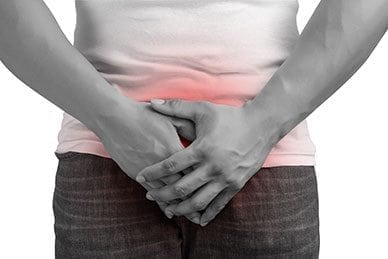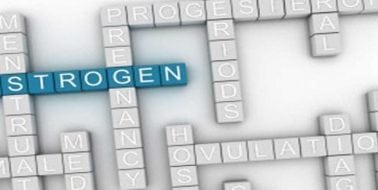Estrogen Dominance in Men Boosts Risk of Prostate Problems and More
Estrogen is the hormone most commonly associated with women. However, men's bodies also produce estrogen. In women and men alike, a certain amount of estrogen is needed for optimal health. For men, estrogen plays an important role in hormone balance, brain function, bone health, skin health, sexual function, heart function, circulation and maintaining healthy cholesterol levels. However, too much estrogen in a man's body quickly becomes a problem.
 There are many negative health effects associating with having too much estrogen as a male. Here are some of the most common symptoms of excess estrogen in men:
There are many negative health effects associating with having too much estrogen as a male. Here are some of the most common symptoms of excess estrogen in men:
- accumulating fat around hips, buttocks and thighs
- depression
- erectile dysfunction
- fatigue
- gynecomastia (male breast growth)
- loss of muscle mass
- low libido
Too much estrogen can have even more serious complications; an excess of this hormone can negatively affect prostate health. Research suggests that having too much estrogen can lead to benign prostatic hyperplasia, or BPH. This condition is essentially an enlarged prostate. Symptoms of BPH are usually restricted to urinary problems such as having to urinate very frequently, having difficulty starting urination, having a weak urine stream, painful urination and even bed-wetting. BPH is considered an age-related condition, as mostly older men experience it; however, suffering from estrogen dominance will probably increase your risk. Benign prostatic hyperplasia should be treated, as should any accompanying hormone imbalance—failure to do so could lead to complications like bladder stones, bladder damage, kidney damage and urinary tract infections. Some experts even believe that estrogen dominance can increase the risk of prostate cancer.
Causes of Estrogen Dominance in Men
In men, many factors can contribute to rising estrogen levels:
- aging
- environmental toxins
- injury or infection of hormone-producing glands
- liver problems
- obesity
- phytoestrogens
- sleep deprivation
- stress
Research suggests that men's testosterone levels today are about 25 percent lower than the testosterone levels of men of the same age in the 1980s. Lowered testosterone means increased estrogen, as it is the ratio of these two hormones that is important. This modern epidemic of low-T/high-E is due to several factors. Obesity in America, a leading cause of estrogen dominance, has increased from a 15 percent rate to 35 percent since the 1980s. Phytoestrogen-containing foods, such as soy, have become increasingly popular in the West. Plastics containing xenoestrogens are being used more and more, and levels of other environmental toxins have also increased.
What to Eat When You Have Estrogen Dominance
To help combat estrogen dominance in men, increase your consumption of cruciferous vegetables such as broccoli, cauliflower, cabbage and Brussels sprouts. Eat these at least a few times per week. These plants contain compounds known as glucosinolates, which your body converts into other compounds that decrease estrogen activity. You can also take supplements like indole-3-carbinol (I3C) and 3,3'-diindolylmethane (DIM), but your body may absorb the compounds from the vegetables more effectively than from pills.
 Make sure you are getting enough vitamin B12, choline, betaine and folate. These nutrients help your body flush out excess estrogen. Good sources of these nutrients include eggs, meat, fish, shellfish, quinoa, spinach and beets.
Make sure you are getting enough vitamin B12, choline, betaine and folate. These nutrients help your body flush out excess estrogen. Good sources of these nutrients include eggs, meat, fish, shellfish, quinoa, spinach and beets.
Onions, garlic and scallions are rich in high-sulfur amino acids as well as quercetin. These help your liver flush out excess estrogen. Oregano, thyme, rosemary, sage, and turmeric are also thought to be helpful for this.
Eat plenty of omega-3 fatty acids. These are found in great quantity in fatty fish. Eat fish such as tuna, salmon, herring or sardines at least twice weekly.
Avoid phytoestrogen-containing foods at all costs. Phytoestrogens are plant-based chemicals that mimic estrogen in the body. Though they are healthful and appropriate for most women to eat, males should avoid them. The worst offenders are flaxseed, soy products and sesame seeds.
Lastly, try to reduce your consumption of processed foods, which contain preservatives and other additives that can disrupt your hormonal balance. Consider eating organic as well, since pesticides on produce and grain can also act as endocrine disruptors.
Alcohol Contributes to Estrogen Dominance in Men
If you suffer from estrogen dominance, it is imperative that you cut out or at least greatly reduce your alcohol consumption. Alcohol is very detrimental to your liver, which is the organ responsible for flushing out excess estrogen. Alcohol consumption is also a common culprit of weight gain, which increases estrogen. Lastly, beer is particularly high in phytoestrogens, so what little alcohol you do drink should not be beer.
What Else Can I Do?
Another step you can take is to limit your exposure to xenoestrogens, or environmental estrogen-like chemicals. They are found in plastic dishes and cookware, pesticides, herbicides and many personal care products. Look for plastic products and personal care products that are BPA and paraben-free.
Changing your diet, level of alcohol consumption and exposure to environmental estrogens are the quickest changes you can make when it comes to treating estrogen dominance naturally. However, you should also think longer-term. If you are overweight or obese and have high estrogen, it is imperative that you lose weight. Fat tissue actually produces estrogen, so you should try not to accumulate too much of it. Certain herbs can also help men maintain healthy testosterone levels.
If weight loss, dietary changes, supplementation, plenty of sleep, stress relief and avoidance of xenoestrogens do not relieve your symptoms, you likely may need medical intervention. See your doctor if this is the case. Severe cases may call for hormone therapy, or your condition may be due to an underlying problem that needs to be treated.






